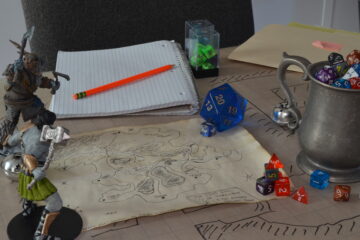There are four players at the table. You’ve known them for a little while, but outside the game store you really only run into them at those odd moments in Wal-Mart where you have to explain to your significant other that this is Alex, my rogue. Awkwardness always ensues.
But you get past that. And we’re back at the table. You’ve made this world that they’re currently playing in (or you stole it! A mighty “Huzzah!” if so), and they’re enjoying it. But this game began as a pick-up in a game store, and so instead of a “session zero” or something of the like, you dropped them right into the action and had them fill in those pesky little backstory deets along the way.
Sidenote: “deets” is apparently a word that Google Docs recognizes.
Because of all of this, your players are in the run-and-gun mindset of adventuring that often comes with organized-play systems. They didn’t really get to start by knowing each other or each other’s characters at all because they are transients in this world. However, while you may have begun with a group of unknowns trying to survive their first encounter with 5 goblins (5!), those characters have now become fast friends who would die for one another. Your players are offering to give each other lifts and buy each other sodas. Friendship has blossomed.
This example has leaned heavily on the store stereotype up until now, but those of us who begin games for new players have felt this same pressure to just get into the story. For new players, the idea of creating a fully fleshed out person can be daunting, and those rails can be the only things keeping them on the road to a fun and enjoyable experience. Most characters need this, actually.
We’ve come now to one of the best parts of running the game. We’ve finally made it to the point, in my opinion, of setting up a world. Let’s talk character-driven storylines.
We’ve made hooks based on our characters’ background traits before. This is the first step of engagement in our stories. The next step sees us handing over the keys of our narrative-focus ferrari to these metaphorically oily-faced teenager-players and letting them take this puppy for a spin. Let’s hand them the map and let them go to town.
I love that one of my players just realized that he can buy the bar. He asked me the other night if he could benefit from owning local stock in an establishment and I was filled with joy. Is it because I love bookkeeping? No (it’s because bookkeeping is the truest form of torture to players, mwahahaha… jk). I’m filled with joy because my player is literally using the in-game resources he has (gold and persuasion) to buy into my world.
I have another player who has made it his character’s mission to seek out one of the BBEGs because A.) The party wants to kill the BBEG, but more so B.) because he wants to harness the BBEG’s power for his own. His goals and dreams are shaping and will shape this campaign from now until the very end.
These are the kinds of stories that players will tell long after everyone has quit or moved away. Like incorporating backgrounds on the small scale, this gives your players new perspectives on how they can interact with a world that they don’t actually live in, and allows them to explore their own agency. Plus, it gives everyone the ability to do things that they wish they could do in real life. (Mansions? Boats? Wildly customizable carts and wagons? You got it.)
In a word, this style of storytelling is described as the sandbox. It’s rolling out the map on the table and saying, “where to?” It’s dangerous, it’s scary, and it means you’re gonna be riffing a lot more in the future. But it also means that your players will get to decide for themselves exactly what they want to accomplish to make themselves feel really cool.
So, how do we do it? When do we do it? Honestly, there are a ton of tools online (I’ll include some links below) for telling you how to make more character-driven stories. Part of it comes from simply asking the people around the table what they want to do next.
As for when, I would say as soon as possible. Or 5th-level. I feel like 5th-level characters should know their way around a map and should be strong enough to pick fights they can’t win and survive. Also, 5th-level is a good starting place for owning property, as you are probably in the top 25-10 percent of power and money level in your main town. Also, many starter campaigns or adventures wrap up within Tier 2 play. (5th-10th level).
As always, please feel free to leave a comment either here on our website or on the Facebook page. If there is a specific topic you want us to discuss, or if you’d like to join us in writing and publishing articles, please let us know!
Thanks so much for joining us, and until next time, keep on rolling!
-Dalton
EXTRA CREDIT:
Matt Colville Sandbox vs. Railroad Video: https://www.youtube.com/watch?v=EkXMxiAGUWg
Zee Bashew How I DM Video: https://www.youtube.com/watch?v=vKQv4GC0N9Q&t=1s
MCDM’s Strongholds and Followers Book: https://shop.mcdmproductions.com/collections/strongholds-followers-books
